SDKsupplies
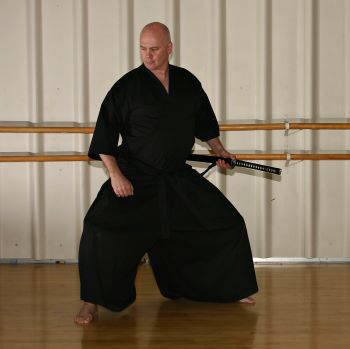
Kim Taylor performing Uki Gumo
Ken Morgan for TIJ: Personal questions first: When and where were you born?
Kim Taylor: I was born in Port Stanley Ontario in 1956. It's a fishing village a thousand plus miles from the ocean, which might explain some things.
TIJ: Married?
KT: Yes, to a lovely and talented woman who has stuck around long enough for us to have a couple of amazing kids.
TIJ: Last book read?
KT: I guess that would be James Sidney's new book The Warrior's Path that was reviewed in The Iaido Journal in December 2003.
TIJ: Last movie seen?
KT: Lord of the Rings: Return of the King. Saw it on a big screen with the kids, we sat in the very front row and turned our heads from side to side to watch it. I spent the next day trying to figure out why my neck hurt.
TIJ:. Favorite current Television show?
KT: Well the only one I make a conscious effort to watch is Star Trek: Enterprise. Gotta love the casting of Jolene Blaylock as a Vulcan.
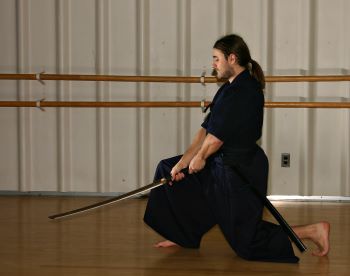
Dennis Nikitenko, Sei Do Kai student
TIJ: Any hobbies, outside of martial arts?
KT: After a 20 year layoff I'm getting back into photography and having a ball. I'm doing a lot of model photography, hence my interest in Blaylock. I used to do woodworking as a hobby but that's pretty much evolved into a business now. I make and sell martial arts practice weapons.
TIJ: Photography? Anything we can see?
KT: Yes of course, you can check out http://taylorteam.netfirms.com/ to see a very non-professional and incomplete site. There are links to online critique sites that I've used for a while to see what I could come up with. I've been working on duplicating the lighting styles you find in various fashion magazines and those sites are great for getting the conservative opinion on your work. Ideal if you're trying to copy what's popular. I think I'm starting to get a more modern "eye" for photos instead of looking like I'm 20 years out of date.
TIJ: What prompted your initial interest in the martial arts?
KT: I suppose I got into Aikido in 1980 because I couldn't find a Zen temple anywhere nearby. I figured anything Japanese had to be Zen right?
TIJ: Why an interest in Zen? Or things Japanese for that matter?
KT: The usual searching of a 20 year old for the meaning of life I guess. What's it all for, why are we here, where do I go, why can't I get laid with any regularity. That sort of thing. Zen at that age seemed to be a simple methodology that didn't require massive amounts of study, money or taking up of arms against other religions. I've never been terribly interested in Japan or the culture per se, just in the art, the aesthetic. I've always been more interested in the minimal, in what isn't there rather than how much you can cram on. So while some traditions will try to add ornament on top of ornament, a "traditional" Japanese room will allow the grain of the wood it's constructed from, to be the ornament. Zen always struck me as a stripping away of extraneous rationalization rather than an adding on of dogma. Japanese martial arts are the same, I've always said that iaido is a process of reduction, if you can't figure out why you're making a certain movement, don't make it. Reduce the kata to the absolute minimum.
Put more simply, I think I'm a bit autistic, I don't like too much stimulation, I've always been a bit of a loner. I don't call folks much, don't go out of my way to visit friends or meet new people. Rather ironic that I've ended up as an instructor I suppose.
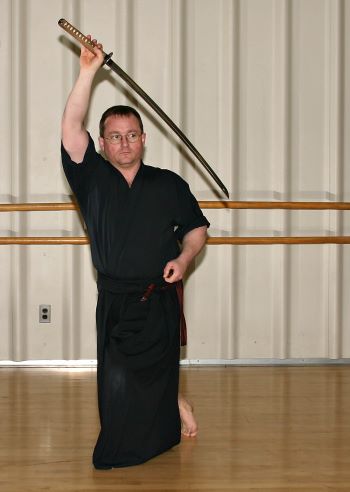
KT: I practiced Aikido for about 13 years under Bruce Stiles and managed to get a shodan in the amazingly swift time of 11 years. I stopped practicing Aikido regularly because I didn't have time for both it and Iaido, and with Stiles sensei around, I certainly wasn't needed to teach. I did Tae Kwon Do for about 9 years and more or less accidentally ended up with a blue belt. It's a kid's art, if I tried a jumping spinning crescent kick now I'd likely break a hip. Along the way I also dabbled in such interesting stuff as Kung Fu (Do Pi), Boxing and even a locally invented Ninjutsu (I didn't invent it, despite repeated accusations to the contrary). In 1983 I began my iaido training at an Aikido summer camp with Mitsuzuka Takeshi, and in 1987 I started training with Ohmi Goyo and Stephen Cruise who have been my sensei ever since. I currently hold a renshi rokudan in Iaido from the CKF. I also practice Jodo under Namitome Shigenori of Fukuoka and hold a yondan from the CKF. Around 10 years or so ago I also managed to start practicing Niten Ichiryu with Haruna Matsuo during an iaido seminar. This last year we had the great good fortune to host a seminar with Imai Masayuki, the 10th headmaster and Iwami Toshio who has been designated the 11th headmaster as well as Colin Watkin who is a senior student of the school. I hold absolutely no rank or recognition whatsoever in that school, nor do I ever expect to. I also teach the women's self defence program for the Athletics Department at the University of Guelph and I get paid a bit less than $10 an hour for that one which is rank enough there I suppose.
TIJ: Tell us about your early years in Iaido? Who have been your instructors?
KT: Well my first was Mitsuzuka Takeshi sensei who teaches Muso Shinden Ryu and is a member of the ZNKR. After I started practicing with Ohmi and Cruise sensei I also had the fortune to spend some time with several other instructors over the years for various times from a day to several weeks. At the moment I can think of Don Harvey, Mark Sykes, Trevor Jones, and Brian Bettison from the UK, Kanai Mitsunari, and John Ray from the USA, Haruna Matsuo and at least 15 other instructors from Japan... you know there are really just too many people who I've been fortunate enough to learn from to recall without sitting down for a couple of hours and thinking about it. You're talking about 20 years of practice here.
TIJ: Is there a… special/pivotal moment that you will always remember from one particular instructor?
KT: Of course. I spent a week with Don Harvey at his house in England and we practiced 3-4 hours each evening after he finished work. His dojo was a converted garage and he was absolutely happy to be there night after night working on his iai. Unfortunately he got dragged a bit deep into the organizational politics and eventually quit iai.
I stayed another time in Rochedale, Lancashire, at Alan Tattersall's dojo wth Ohmi and Haruna sensei. After a day or so of listening to those two speaking Japanese and Haruna smoking like a chimney, I'd had enough and went downstairs to practice in Alan's ice-cold dojo. I might have been there 10 minutes before I heard Haruna's voice behind me correcting a mistake. The three of us spent the rest of the afternoon beating the crap out of my technique. Lord I miss Haruna sensei, he passed away suddenly a couple of years ago and it's been a bit of a mess ever since.
I remember rainy Sunday mornings in Toronto waiting for Ohmi sensei and Cruise sensei to show up at the old Japanese Canadian Cultural Centre. Maybe 7am and nobody around but me in the back of that marvelous Ray Moriyama building swinging a bokuto at a leaf with the water dripping down my neck. As I think back on it some of my happiest moments were as a beginner just soaking up as much information (and sometimes rain) as I could.
I remember John Ray and me in my back yard trading techniques. I remember Trevor Jones yelling "what does tennis mean?" after I'd asked him once to many times what a technique name meant. I remember Iwata sensei teaching impeccable seitei gata in Vancouver. I remember doing iaido at the World Kendo Championships in Toronto and watching all my students get ranked above me. I remember Haruna sensei in his underwear at 2am in Chris Nunan's kitchen demonstrating shiho barai with a chopstick. I remember all my students.
TIJ: What do you get out of iaido, or better yet why do you still practice Iai?
KT: Why do I still practice? Habit I suppose, more than anything else... or perhaps I should say that's why I still teach. I suppose I still have something to give to people but there are lots of good teachers out there now, and there are a dozen or more of my own students who I know can teach anything I can teach. I guess I still teach because I remain useful to the art in certain ways, I organize seminars and have a small role that I play in the organization. Eventually I'll become redundant and then maybe I'll retire just to practice on my own.
As to why I practice iaido... it's because there's something about the art that benefits me. Iaido is a form of meditation, it's a way of examining myself and a tool to use to improve myself. After 20 years at it I'd like to think that there isn't really much that I haven't figured out technically, although I suspect I can improve here and there, but mentally and, dare I say it, spiritually I guess I'm still working away at it.
TIJ: What role do you play in the organization, and would you like to expand that role?
KT: You're kidding right? It's a truism that anyone who wants to be in charge is the wrong person for the job. Plato knew that in 360 B.C. Read The Republic some time. Those who want to be in charge of volunteer organizations tend to be folks who don't have the interest of the organization at heart. Thankfully, it sometimes happens that those who actually are in charge DO care for the good of the organization. They can see beyond their own agenda. When those folks get replaced by the wannabe types the organization simply dissolves. The only thing holding any volunteer system together is a sense from the top on down that actions should emerge from something beyond personal feelings. It's more or less the definition of volunteer. Guys "with a vision" that want to dictate what happens should stick to the business world, volunteers don't have to stick around and listen to it. You need to pay people to take that kind of silliness.
Fortunately, I am neither in charge, nor desire to be in charge. I look after the CKF website (and not very well at that). I have enough trouble taking care of my own club.
TIJ: What do you look to instill in your students?
KT: Absolutely nothing. I suppose when I was younger and much more stupid I thought that I could provide a good example and teach the martial arts to my students as a way of improving themselves, that I could somehow make my students into better people. What arrogance instructors can have! Now I'm happy if my students show up at class and continue to train. I have little interest in producing high ranking students who win tournaments and breeze through their gradings. To tell the truth, there's much more to be learned from failure than from success. What do you learn from winning? That you're the least talentless person on the floor that day, that's about it. I would much rather see a student just show up as often as possible and just get on with training. I'm proud of course of my highly talented students but I'm equally proud of the guys who show up week after week and grind away at it, coming back time after time to take a grading and never complaining when they fail. More than anything it's those guys that keep me around, that keep teaching me what the martial arts really mean.
Back to personal growth... In class I'll make suggestions and my students will try to do what I suggest. The act of practicing itself will produce any changes in the student. My job, as I see it now, is to show up and say "start" and "stop" and to provide the occasional suggestion on posture and perhaps attitude for a specific place in the kata.
I like to yell "I'm not your mother" a lot, and this sometimes makes my students laugh but I'm deadly serious. I can't learn this stuff for my students and I've certainly never been taught how to "directly transmit" skills by any other means than to simply sit down together and practice. If there's some way I could poke a student on the forehead or knock them into the mud and provide instant enlightenment I would do it, but I'm just not that spiritually advanced, and I'm now old enough to be smart enough to realize that.
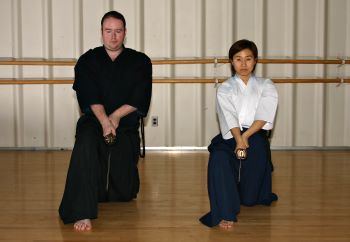
Jeff Broderick and Misoo Ko
TIJ: What does one have to do to join your dojo?
KT: Get your ass onto the floor. That's my "dojo test" actually, and I suppose by explaining it here it will become useless but I'll do it anyway in the full knowledge that people don't really listen anyway. Some instructors have special requirements that their students must fulfill, they must sign a blood oath, they must pay a lot of money, they must sit outside the gate for a week in the rain, they must learn a "crippled version" of the art or some such. This is all supposedly a way of judging the student's character before they get into the dojo. It's all crap, it's a sales gimmick and it appeals to our notion that "you get what you pay for". If it's hard to get in (but not so hard that you can't get in of course) than it must be special.
Well my test is slightly different. I tell people the truth, I'll teach you if you show up in front of me. It won't cost you much and you won't have to jump through a hoop, you just have to sit down in front of me and I'll do my best to show you everything I know.
Do you know that not once, not one single time has someone contacted me asking me what test they have to pass to join, have they actually put their ass on the floor! My test is the toughest of all, it's the one that requires a leap of faith... "surely this guy must be a lousy instructor if he'd have me in the dojo with no test of my character!" "I wouldn't want to join any club that would have me as a member!" It's a tough test, I'm selecting out those who figure I've got something secret to tell them. I don't, it's just "show up and practice". If I had a special hoop to jump through people would eventually be disappointed that the practice is nothing special... but that's the secret isn't it? Nothing Special, not me, not the art, and horror of horrors, not even you.
TIJ: You sound like a pragmatist.
KT: I'm old, well older some days than others, the answers I sought when I was 20 have all been answered and they weren't all that shocking, or even enlightening for that matter. It turns out that what the old men said when I was a kid was pretty much it. They weren't lying or hiding the truth, it was as simple and corny as it sounded when they said it. Can't live because your girl dumped you? "Time heals all wounds". What should I do? "Be nice, try your hardest". What's the meaning of life? "Wait until you have kids, then you'll understand". Am I a bad person? "It takes two people to have a fight".
Not that going on the search was a bad thing, I understand why it isn't going to do me any good to tell my students and my kids the simple answers. I'll tell them anyway but they won't believe me, they'll need to grow old enough to figure it out themselves.
TIJ: What is your opinion of Canadian iaido?
KT: As what? It's where I am, it's what I do, it suffices for my needs. If you mean how is the technical level of Canadian iaido compared to the rest of the world, I've been told by people from the rest of the world that it's fine, our 3dans are as strong as 3dans elsewhere, including Japan. I don't worry about it.
If the IKF ever gets around to doing a world championships for iaido I'm sure there are some nice competitive folks in Canada who will be there and I'm also sure we'll place quite respectably.
TIJ: What are your future Iaido plans?
KT: Well I'd like to see my students continue to teach their students, that gives me a lot of satisfaction, especially when I see those students do well. Beyond that I don't really have any plans for myself, I keep feeling guilty that I'm not doing more to spread the art but I'm afraid my missionary days are in the past. I leave that to the enthusiasm of the younger generation. I'll continue teaching the 14 or 15 people in the dojo, same as I've been doing for the last decade or more and I won't worry too much about numbers. It never really changed anyway, even when I was actively advertising and trying to get more bodies through the door.
Did you mean rank? I used to worry that I needed some rank to provide respectability to the dojo and the art and whatnot but I looked around the class the other day and saw a couple of 4dans, a couple 3dans, a bunch of 1 and 2dans and an equal number of beginners. Even if I didn't figure I've got all the iai rank I'm ever going to need, I wouldn't worry about it. I don't even need to be in class, the club and iaido in general is going to survive without me quite well thank you. It's a nice feeling.
TIJ: What do you look for in gradings or competitions?
KT: It depends on the grade, in the lower ranks I look for surface technical ability mostly. Since that should be learned in 2-3 years I start to look a bit deeper, to whether or not the student understands the meaning of the kata. I look at how the student handles mistakes, how they handle the pressure of the examination. Grace under pressure and all that.
Life is this moment, here and now. The martial arts should teach here and now, because if you're stuck somewhere in the past, the future, or three blocks over you're going to die. I look at what is happening here, now. Did the student live or die? I don't look much beyond that as a rule.
For competitions it's simple, least bad gets the flag.
TIJ: What about Jodo? What’s your background there?
KT: Well many many moons ago I was given Pascal Kreiger's book by John Prough from NYC. A bunch of us aikido types went though the kihon to see what we could see. Years after that I went to an iaido seminar with Suzuki sensei down in the States and he was teaching jodo as well. I must have looked like a fast learner because I was asked to continue practicing jo and I agreed to do the "seitei jo" set of the ZNKR since I was already practicing two other koryu and didn't want to take on a third. I went on to practice informally for a few years with a few students from Ontario and eventually folks decided they wanted to get more serious about jodo so we made our connection with Namitome sensei through Ide sensei and created the jodo section in the CKF. I'm now practicing a bit of koryu but we still concentrate on seitei, there's lots to learn there without going kata collecting.
TIJ: What are your thoughts on the future of Jodo in Canada? Where is it going?
KT: Good question. There seems to be a little jodo boom going on at the moment, with lots of people on the net figuring it's "the one" like they thought judo, karate, kung fu and ninja was in previous generations, today it's "koryu". But the net only gives the illusion of popularity, the general kid on the street hasn't heard of jodo and if he sees it, won't be overly impressed. It's a weapons art and so it's doomed to relative obscurity unless it somehow becomes an Olympic sport... but hey, how many people fence? Even Olympic status doesn't help.
Jodo will continue to grow slowly in the CKF, we've got a good core of people teaching it who are dedicated, and it hasn't started to suffer any of the splintering that other arts are going through yet, so the group is focused. Namitome sensei will direct the growth well I think.
TIJ: What about Niten?
KT: I have mentioned my connection with Haruna sensei who taught us the Niten Ichiryu many years ago. I practiced that quite seriously for several years but with the death of Haruna sensei I more or less put down my sticks since I had no instructor. However, the interest in the school remained amongst the students and eventually we contacted Colin Watkin (Hyakutake) and asked Imai sensei to come and teach us, which he did last summer. It's handy to have Niagara Falls nearby as an enticement! We hope to see them again this summer.
TIJ: So I take it that formal niten instruction has become a regular occurrence in Guelph?
KT: That depends entirely on the students, on how keen they are to study it and on how much benefit I see them getting from it. Niten practice is quite different today than the other arts. I don't mean it's anything special or secret or that the techniques are anything that the students can't see in the other arts we study, but the method of practice is different. The goal is being approached from a different angle. If the students can catch that, we'll continue to practice it, if they don't I'm not going to ask Imai or Iwami sensei to come over and re-invent the wheel every year. That would be insulting. As long as there's improvement and sensei can see that we're learning...
You know, it's very difficult to maintain all the different arts we have practiced over the years at Sei Do Kai. When I started jodo I only promised to do seitei because I couldn't see taking on another koryu. Now of course, Namitome sensei has introduced jodo koryu so we have no choice in the matter. Haruna sensei once stated that you can only chase so many rabbits, if you're a professional martial arts instructor maybe you've got time for two or three different arts but most people have a life, a job, a family and that's why the various arts cut down to where they are today. Nobody really needs to know how to handle 15 different obsolete weapons and three different unarmed arts. One or two is enough. You'll get as much out of learning iaido as you would learning iaido, jodo, niten ichiryu, aikido, and lord knows what else. More in fact, since people who try to learn too much end up learning nothing.
This is one of those things that the old men say that the young men never believe. The 8dan tells you that he would be happy practicing mae for the next 2 years and the youngster thinks he's only saying that to keep him working on mae for the next week or so. In fact sensei isn't lying, as you get older you understand that "kata collecting" is about as useful as "sport card collecting". Better to go deep than to splash around in the shallows chasing every new tombo that comes along.
At one time I believe I knew almost 200 iaido kata through about 7 or 8 schools, and could have sat down and showed you each one with explanations. I think I might not be able to do that today.
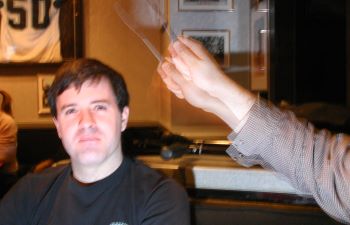
Ed Chart and Jeff Broderick (with weapon)
Discussions on sword technique are often carried out in the bar
after practice.
This exotic technique is being illustrated with a sophisticated
multiple flash photograph.
TIJ: Guelph has been…. notorious for holding various seminars throughout the years, in iaido, Jodo and recently Niten. Specifically the May Haruna seminar, The Guelph School of Japanese Sword Arts in July, A Niten seminar in August and various Jodo seminars through out the year. Why do you go through all the trouble and expense of putting on such events?
KT: I suppose because we can. The Haruna seminar was, and still is organized as a way to get instructors over for my sensei. I have always had enough to work on for myself from my instructors, but how do they get instruction? The solution was the seminar. Now the iaido seminars have over 100 students but the focus is still, as far as I'm concerned, on providing instruction to my instructors. I mean really, do kids with three years of practice really need an 8dan teaching them directly? If they're not learning it from our 4dans they aren't going to learn it from an 8dan. The jodo seminar, on the other hand, is entirely selfish. If I am going to teach and practice jodo I need to know what I'm doing, so the jodo seminar is for me and for the other jodo instructors in Canada. The students only get to come practice because we need them to pay the bills. (laughs).
TIJ: You also make excellent wooden practice weapons, (which you sell at SDK supplies), why did you start doing this?
KT: I started very early, in the first year or two of my Aikido practice. We practiced weapons at Guelph from day one, and the bokken came from Japan. I thought they were pretty nice things and carved one for myself out of a 2 by 2. I then started supplying other students with weapons and over the past 20 years have ended up where I'm now occasionally sending weapons to Japan. It was a hobby that just sort of grew.
TIJ: You also produce various instructional videos/books, why?
KT: Theoretically so that my students don't ask me the same questions over and over and over as the years go by. It was the students who asked for them in the first place and so we produced them. Then we got the idea of selling them to gain some money to support the seminars. It worked and we're still selling them. The books are actually my student notes, what I learned I wrote down and that was the basis for the books. The videos are really just me standing in front of a camera teaching a class, but without the inconvenience of students. You can get SO much more done in 2 hours without students to watch and correct.
TIJ: Your favorite martial arts moment is?
KT: Tomorrow evening at 7pm, next class.
TIJ: Thanks for chatting with us today sensei.